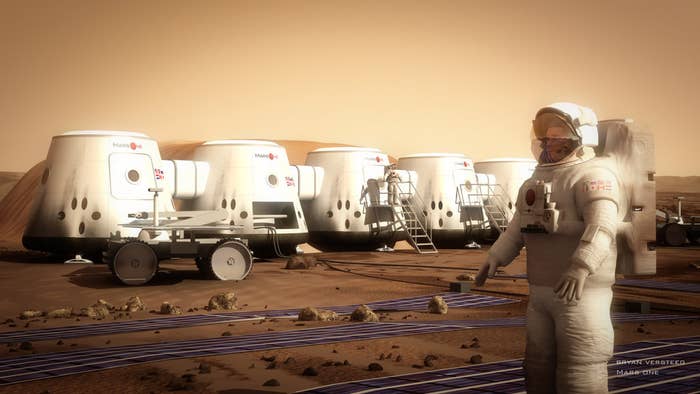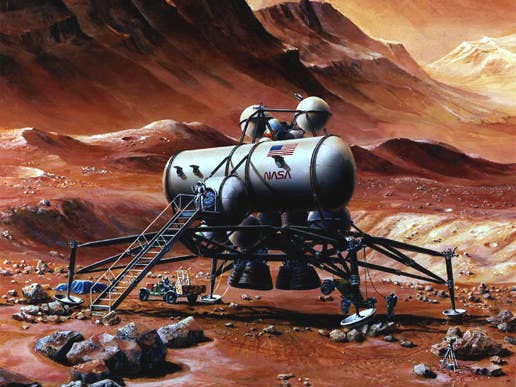
Last week, the nonprofit reality-television project Mars One announced its selection of 100 volunteers who may get one-way tickets to Mars. It's only the latest in decades of celebrated Mars colonization projects. And just like all the rest, this one is unlikely to ever happen, experts say.
"It looks like a scam," John Logsdon, a space policy expert at George Washington University in Washington, D.C., told BuzzFeed News. "They don't have any technology, they don't have any agreements with the space industry. It looks very shaky."
The bigger problem? Mars One's flaws — too few spaceships, nonexistent life-support technologies, not nearly enough money, and, really, no good reason for going — discredit all Mars exploration plans, including NASA's.
Although these hurdles are obvious to everyone in the space industry, politicians have spent decades trumpeting Mars plans, only to cut and run when presented with the bill for their interplanetary adventures.
In Congress, the House science committee sent a bill to the Senate this month, to "make clear that Mars should be NASA's primary goal," according to a committee statement. And in his State of the Union speech last month, President Obama invoked "a re-energized space program that will send American astronauts to Mars."
But all of that is mostly theater, political scientist Alan Steinberg of Sam Houston State University in Huntsville, Texas, told BuzzFeed News.
NASA's budget, adjusted for inflation, has steadily shrunk for decades. And that's because the public and voters don't want Martian cities more than they want stuff on Earth, such as Social Security checks or a Defense Department.
Last year, a National Research Council report on Mars missions came to a similar conclusion. Asked by Congress to come up with one solid rationale for going to Mars, the report panel instead offered a grab bag of vague reasons for blasting off, such as inspiration, industrial goals, and prestige. But those squishy notions won't cut it, not as NASA's buying power continues to plummet, Steinberg said. "Talking about Mars just looks like a way to placate the public while they cut NASA's budget."

Calls for Mars colonization continue an imaginary real estate rush first launched in the 1890s.
That's when astronomer Percival Lowell claimed, mistakenly, that there were canals — and therefore Martians — on Mars. Sixty years later, the rocket pioneer and former Nazi Werner von Braun wrote a popular series in Collier's magazine outlining how to send 70 men to populate Mars. The idea of Mars landings has been embedded in NASA's mind-set ever since.
Despite decades of Red Planet rhetoric, Congress has never really increased NASA's budget for manned Mars missions. When it comes to Mars, Logsdon said, "there has been a mismatch between aspirations and reality since Nixon."
And now there's Mars One, the Netherlands-based nonprofit that aims, a decade from now, to establish a "permanent human settlement on Mars."
Mars One plans to finance the estimated $6 billion cost of the one-way trip to Mars with donations and through a reality TV show that follows the selection of its volunteer Martians. In crews of four, those colonists would depart in 2024 and 2025, traveling six months in a trailer-sized box to land on the planet and live out the rest of their lives.
But their lives would last only about 68 days, according to a study published last year. "Keeping people alive on Mars is a lot harder problem than most people realize," MIT aerospace engineer Sydney Do, one of the study's authors, told BuzzFeed News.
Mars makes Antarctica look like paradise, with a near vacuum atmosphere, radiation as intense as multiple chest X-rays, temperatures that average -67 degrees Fahrenheit, and toxic chlorinated hydrocarbons carpeting its cratered surface. No technology exists today to survive under these conditions, let alone a human body.
Mars One's engineers say they can overcome those natural barriers with a crew habitat made of six modified SpaceX Dragon space capsules equipped with inflatable greenhouses. The trouble is, according to Do's report, the plants growing the colonists' food would quickly make too much oxygen and suffocate them.
That's just one of many fatal problems. Spare parts, for example, would take up 62% of the mission's supplies. And the colony's intended water supply — H2O baked out of that chlorinated Martian soil — relies on a technology that hasn't been invented yet.
Then there's the expense. The Mars One launch would need 15 interplanetary rockets, nine more than Mars One suggests, the MIT report found. Those rockets, which have yet to be tested, would alone cost $4.5 billion, never mind the cost of habitat modules, developing technologies, and resupply missions.
"I think it will happen eventually — people will go to Mars," Do said. But "Mars One is not going to be the one."
In response, Mars One CEO Bas Lansdorp told BuzzFeed News that the MIT study "made many wrong assumptions and sub-optimal design solutions." All of the study's critiques "were already taken into account," he wrote by email, and these issues will be addressed in a report in early March. "We hope to have the public report soon after that," Lansdorp said.
Even if Lansdorp is right that MIT's engineers know less about space survival than a reality TV show, plopping people down on Mars to live permanently would only work if they were constantly resupplied at ridiculously expensive costs by a fleet of rockets filled with replacement air purifiers, electronics, and anything else breakable, as well as tons of astronaut chow.
Food, as analyzed in the MIT study, would actually be cheaper to send to Mars than to grow there, even shipped on rockets that cost $300 million a pop, because of infrastructure costs.
For years, SpaceX rocket entrepreneur Elon Musk has talked about a Mars mission that would do just that: constantly launch rockets to resupply a Martian settlement. If they somehow managed to beat the suffocation problem, "people might live for five decades after a landing," Do said. "It's like trying to drive a car for 50 years — you start to need a lot of spare parts to keep things going."
"And at a certain point, you'd have to ask yourself," Do added, "if all I'm doing on Mars is maintenance work in a cave to keep myself alive, why did I even come?"

But what about the more modest Mars exercises envisioned by more credible organizations, like NASA?
According to its current plans, the space agency will send astronauts to orbit Mars in the 2030s using a monster-sized version of the Space Launch System (SLS) rocket now under development. Much later, around 2060, an international expedition would actually land on the Red Planet.
At first glance, those plans look to be proceeding. In December, NASA test-baked its new $9 billion Orion crew capsule on an unmanned re-entry flight through Earth's atmosphere that successfully simulated the 4,000-degree-Fahrenheit roasting that comes with the return of a lunar astronaut mission.
"The successful test launch of Orion demonstrates that we are on the right track for sending humans back to the moon and Mars within our lifetime," said Rep. Steven Palazzo, chair of the House space subcommittee, at a recent hearing.
There's just one thing missing, and it's always been missing: money. On the 20-year anniversary of the Apollo moon landings in 1989, for example, then-president George H.W. Bush proposed a Mars landing mission that crashed in Congress soon after its price was estimated at $500 billion. His son, George W. Bush, proposed a 2004 plan to return to the moon, and eventually Mars, that died in 2009, in part the victim of cost estimates suggesting that NASA would need to ramp up its annual spending by about $3 billion.
The Obama administration plans to send astronauts aboard Orion on shorter stepping-stone trips to nearby asteroids before heading to Mars. Congress and the White House are already feuding over funding these asteroid missions. The Government Accountability Office testified at Palazzo's hearing that SLS was underfunded by about $400 million. And a National Research Council report last summer suggested that SLS budgets would need to grow about 5% a year for a decade or so to successfully head for Mars.
"I had no idea funding problems would come on so quickly," said House science committee member Rep. Dana Rohrabacher, a voice of doubt at Palazzo's hearing. "To say we have put the cart before the horse is an understatement with a $10 billion expenditure to build this monster rocket, which won't even have a mission for two decades."
"I'm glad that didn't stop Apollo," quipped Rep. Bill Posey of Florida. Posey's district includes Cape Canaveral, which benefited enormously from the $119 billion (in 2015 dollars) Apollo program.
But Apollo has been dead for four decades, alongside the Cold War rivalry that birthed the moon race, Steinberg said.
In a 2011 paper in the journal Space Policy, he showed that since the early 1970s, NASA's budget has steadily been watered down by Congress, with small increases overtopped by inflation even as the space agency was asked to do more with less, including flying space shuttles, building a space station, and exploring nearby planets. All the while politicians made bold proclamations about Mars.
"We need a real reason to go to Mars — some international rivalry or economic benefit, not just prestige. Or ultimately the money won't be there," Steinberg said. "When you ask people to cut something else to go to Mars, they don't want to do it."
